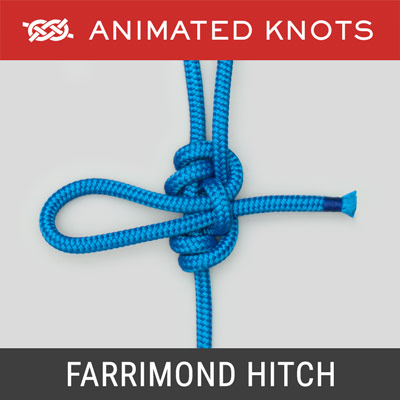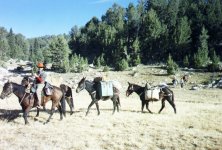I use a bowline and a Blake's hitch every time I put my boat on my car, for the bow lines. I rely on the Blake's hitch instead of a trucker's hitch (tensioning bow/stern ropes while car-topping) and instead of a tautline hitch for tarp and tent guys. The Blake's originated in arborist-style tree climbing, and holds much better than a taut-line hitch and can be slacked and un-slacked easily (admittedly hadn't thought that you might WANT a hitch to slip on a tarp in a storm - good point! But you don't want slippage usually). I have a Blake's hitch pretty much permanently tied in my bow painter, which serves more often during car-topping than as a painter on the water. A carabiner clips the loop of the Blake's to the anchor point on my car. I have climbed on both a Blake's hitch and a taut-line, and the taut-line can slip A LOT when it matters. Extra turns can be added to the Blake's hitch for extra security or better hold in a slippery rope. I use a "3-2" when car-topping with 3/8 line, instead of the typical "2-2" set up (learn a Blake's hitch and you'll understand what I'm referring to - otherwise don't worry about it!)
While tripping, a Blake's is likely to come into play again with tarps, and I will frequently use what was taught to me as a "tensionless hitch", though it more resembles the
round-turn on the animated knots site. I add enough turns (often 3), making sure the rope crosses itself, to capture tension towards the load, and then finish off with a slip-knot on the standing (loaded) part of the line, secured with a half-hitch turn over the slipped bight, rather than a
carabiner or half-hitches as shown in the round-turn example above. The slip-knot is super easy to un-do; the half-hitch over the slipped bight prevents accident release. I often use this for securing a food hang, but also for tarp guy lines at times. Slip-knots secured with a half-hitch have tons of uses I find.
When tying a boat to shore with a bow painter I usually just do two or three half-hitches on a bight - I learned the highwayman's hitch for such occassions but haven't used it yet.
A girth hitch is often useful for various things, most recently putting bits of flagging on black tarp guy lines for easily-removed visibility.
I have practiced a Munter's hitch a lot to make sure I have it in my back pocket for a rescue situation.
A water-knot for webbing is useful for creating webbing slings to hang a boat from rafters in storage. Tie it right before you load it - once tensioned under weight, it ain't coming out.
The fisherman's and double-fisherman's knots, and a double-fisherman's loop, are extremely useful for lanyards, loops for prussiks, etc. I often prefer terminating an end in a double-overhand knot tied on the standing end of the line rather than a bowline or a figure-8 on a bight/re-fed figure-8, since the double-overhand will cinch down on a carabiner or other object. It's my preferred method for attaching a life-line during climbing, as it reduces the risk of side-loading a carabiner greatly. Once the carabiner is removed the knot comes out easily. If you tie this around a tree or similarly immobile object it will be a bear to undo after loading.
I learned a lot taking courses on arborist style tree climbing. Beyond the Blake's hitch (my go to friction hitch) and many others Pblanc mentioned, a couple really useful 'tricks' are the sliding double-fisherman's loop and a clove-hitch with half-hitches instead of a sheet bend. The
sliding double-fisherman's loop is a great substitute for a regular fisherman's loop, because 1) you can secure an object like a carabiner or tool at one end, and 2) you can easily undo it by sliding the knots over one end of the loop, whereas a regular double-fisherman's loop is very hard to undo once it's been under tension.
For the clove-and-half-hitches, imagine you're trying to get a thick (say 1/2in diameter) line up over a tree branch to hang a food bag away from raccoons or whatever. You use a thin (say p-cord size) line to throw over the branch, and then connect the two lines and use the thin line to haul the thick line over. Now a sheet bend is a fine knot for joining to lines of different diameters, but when you try to pull it through a narrow opening, you've double the thickness of the thicker rope and it will often hang in the tree or other constriction. Instead, tie the thin line in a clove hitch around the thicker line about 6 inches from the leading end, then tie a half-hitch around the thick line about 4 inches from the end and another again around an inch from the end. You now have a streamlined set-up much more likely to successfully let you haul the thick line through the constriction using the thin line. I've used this trick getting lines into trees, but also had to use it recently re-doing the window-sash counterweight ropes that broke on a window at home.
Finally from the tree climbing world (and maybe elsewhere but that's where I learned it) is the concept of Tie-Dress-Set. You tie a knot, then dress it (make sure all the loops, turns, etc are laying as they should, and working slack out of where it shouldn't be), then set it by applying tension in the right places. Many knots, especially friction hitches, will not function unless properly dressed and set. It's one of those ideas helpful when you're learning a new knot; with practice it's a smooth and unconscious process, but learning this way helps avoid issues like improperly tied bowlines, slipping or jamming friction hitches, etc. Remember to dress and set a bowline will significantly reduce the chance of a capsized knot (I still finish off with an overhand knot or Yosemite bowline just in case.)



